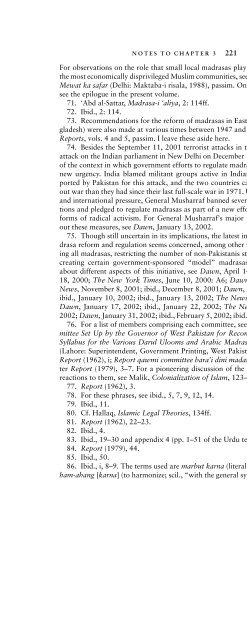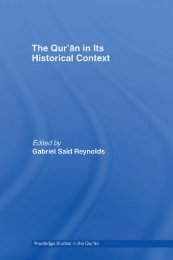Download (1 MB) - Islam and Christian-Muslim Relations: Articles ...
Download (1 MB) - Islam and Christian-Muslim Relations: Articles ...
Download (1 MB) - Islam and Christian-Muslim Relations: Articles ...
Create successful ePaper yourself
Turn your PDF publications into a flip-book with our unique Google optimized e-Paper software.
NOTES TO CHAPTER 3 221For observations on the role that small local madrasas play in the life of one ofthe most economically disprivileged <strong>Muslim</strong> communities, see Wahid al-din Khan,Mewat ka safar (Delhi: Maktaba-i risala, 1988), passim. On Wahid al-din Khan,see the epilogue in the present volume.71. ‘Abd al-Sattar, Madrasa-i ‘aliya, 2: 114ff.72. Ibid., 2: 114.73. Recommendations for the reform of madrasas in East Pakistan (now Bangladesh)were also made at various times between 1947 <strong>and</strong> 1971. See Ibrahimy,Reports, vols. 4 <strong>and</strong> 5, passim. I leave these aside here.74. Besides the September 11, 2001 terrorist attacks in the United States, anattackon the Indian parliament in New Delhi on December 13, 2001 is also partof the context in which government efforts to regulate madrasas have acquired anew urgency. India blamed militant groups active in Indian Kashmir <strong>and</strong> supportedby Pakistan for this attack, <strong>and</strong> the two countries came closer to an alloutwar than they had since their last full-scale war in 1971. Under intense Indian<strong>and</strong> international pressure, General Musharraf banned several militant organizations<strong>and</strong> pledged to regulate madrasas as part of a new effort to curtail variousforms of radical activism. For General Musharraf’s major policy speech layingout these measures, see Dawn, January 13, 2002.75. Though still uncertain in its implications, the latest initiative towards madrasareform <strong>and</strong> regulation seems concerned, among other things, with registeringall madrasas, restricting the number of non-Pakistanis studying in them, <strong>and</strong>creating certain government-sponsored “model” madrasas. For news reportsabout different aspects of this initiative, see Dawn, April 14, 2000; ibid., April18, 2000; The New York Times, June 10, 2000: A6; Dawn, July 4, 2001; TheNews, November 8, 2001; ibid., December 8, 2001; Dawn, December 14, 2001;ibid., January 10, 2002; ibid., January 13, 2002; The News, January 16, 2002;Dawn, January 17, 2002; ibid., January 22, 2002; The News, January 30–31,2002; Dawn, January 31, 2002; ibid., February 5, 2002; ibid., February 13, 2002.76. For a list of members comprising each committee, see Report of the CommitteeSet Up by the Governor of West Pakistan for Recommending ImprovedSyllabus for the Various Darul Ulooms <strong>and</strong> Arabic Madrasas in West Pakistan(Lahore: Superintendent, Government Printing, West Pakistan, 1962), hereafterReport (1962), i; Report qawmi committee bara’i dini madaris-i Pakistan hereafterReport (1979), 3–7. For a pioneering discussion of the two reports <strong>and</strong> thereactions to them, see Malik, Colonialization of <strong>Islam</strong>, 123–28, 132–39.77. Report (1962), 3.78. For these phrases, see ibid., 5, 7, 9, 12, 14.79. Ibid., 11.80. Cf. Hallaq, <strong>Islam</strong>ic Legal Theories, 134ff.81. Report (1962), 22–23.82. Ibid., 4.83. Ibid., 19–30 <strong>and</strong> appendix 4 (pp. 1–51 of the Urdu text).84. Report (1979), 44.85. Ibid., 50.86. Ibid., i, 8–9. The terms used are marbut karna (literally: to integrate: p. i),ham-ahang [karna] (to harmonize; scil., “with the general system of education in



